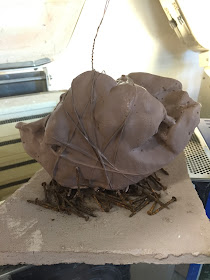"stone is the only thing in nature that constantly dies" - Frances PongeThe solidity, reliability and impassiveness of stone is constant, yet it is continually changing, although at a greatly reduced rate compared with human life. Despite its solidity, it is worn down by atmospheric agents such as air and water, reducing large pieces of stones into pebbles, and then finally into fine particles of sand.
 |
| #40 of 222 Grips for a Stone Before firing |
 |
| #41 of 222 Grips for a Stone After firing |
 |
| #42 of 222 Grips for a Stone Before firing |
 |
| #45 of 222 Grips for a Stone After firing |
Stone is continually changing form, yet at the same time it remains true to its original composition of minerals. In some senses you could say that stone is an illusory force in nature, having the ability to continually morph itself over time. Once it is ground down into smaller particles it has the potential to be transformed into larger stones again through sedimentary processes, or melted under extreme heat in the form of lava.
 |
| #46 of 222 Grips for a StoneBefore firing |
 |
| #47 of 222 Grips for a Stone After firing |
Because of the vast difference in materiality between the unfired and the fired clay pieces, after much discussion and consideration I have started counting the before fire and after fire as different pieces in my exploration of 222 grips for a stone.
Interestingly, the copper wire, which contains or grips the clay before being fired, acts as another grip after firing, as the melted copper sticks the ceramics together.
Ponge, F. The
Voice of Things. Herder and Herder. United States 1974.

No comments:
Post a Comment